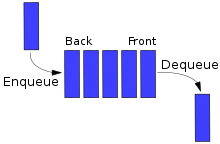
Back FIFO Azerbaijani FIFO (računarstvo i elektronika) BS FIFO Catalan Metoda FIFO Czech First In – First Out German First in, first out Spanish First Come First Served Estonian FIFO Basque خروج به ترتیب ورود (رایانه و الکترونیک) Persian First in, first out (informatique) French
This article needs additional citations for verification. (March 2015) |

In computing and in systems theory, first in, first out (the first in is the first out), acronymized as FIFO, is a method for organizing the manipulation of a data structure (often, specifically a data buffer) where the oldest (first) entry, or "head" of the queue, is processed first.
Such processing is analogous to servicing people in a queue area on a first-come, first-served (FCFS) basis, i.e. in the same sequence in which they arrive at the queue's tail.
FCFS is also the jargon term for the FIFO operating system scheduling algorithm, which gives every process central processing unit (CPU) time in the order in which it is demanded.[1] FIFO's opposite is LIFO, last-in-first-out, where the youngest entry or "top of the stack" is processed first.[2] A priority queue is neither FIFO or LIFO but may adopt similar behaviour temporarily or by default. Queueing theory encompasses these methods for processing data structures, as well as interactions between strict-FIFO queues.
- ^ Andrew S. Tanenbaum; Herbert Bos (2015). Modern Operating Systems. Pearson. ISBN 978-0-13-359162-0.
- ^ Kruse, Robert L. (1987) [1984]. Data Structures & Program Design (second edition). Joan L. Stone, Kenny Beck, Ed O'Dougherty (production process staff workers) (second (hc) textbook ed.). Englewood Cliffs, New Jersey: Prentice-Hall, Inc. div. of Simon & Schuster. p. 150. ISBN 0-13-195884-4.
© MMXXIII Rich X Search. We shall prevail. All rights reserved. Rich X Search